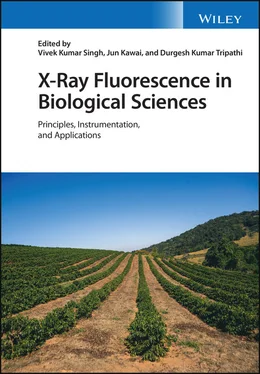X-Ray Fluorescence in Biological Sciences
Здесь есть возможность читать онлайн «X-Ray Fluorescence in Biological Sciences» — ознакомительный отрывок электронной книги совершенно бесплатно, а после прочтения отрывка купить полную версию. В некоторых случаях можно слушать аудио, скачать через торрент в формате fb2 и присутствует краткое содержание. Жанр: unrecognised, на английском языке. Описание произведения, (предисловие) а так же отзывы посетителей доступны на портале библиотеки ЛибКат.
- Название:X-Ray Fluorescence in Biological Sciences
- Автор:
- Жанр:
- Год:неизвестен
- ISBN:нет данных
- Рейтинг книги:5 / 5. Голосов: 1
-
Избранное:Добавить в избранное
- Отзывы:
-
Ваша оценка:
- 100
- 1
- 2
- 3
- 4
- 5
X-Ray Fluorescence in Biological Sciences: краткое содержание, описание и аннотация
Предлагаем к чтению аннотацию, описание, краткое содержание или предисловие (зависит от того, что написал сам автор книги «X-Ray Fluorescence in Biological Sciences»). Если вы не нашли необходимую информацию о книге — напишите в комментариях, мы постараемся отыскать её.
Discover a comprehensive exploration of X-ray fluorescence in chemical biology and the clinical and plant sciences X-Ray Fluorescence in Biological Sciences: Principles, Instrumentation, and Applications
X-Ray Fluorescence in Biological Sciences: Principles, Instrumentation, and Applications
X-Ray Fluorescence in Biological Sciences — читать онлайн ознакомительный отрывок
Ниже представлен текст книги, разбитый по страницам. Система сохранения места последней прочитанной страницы, позволяет с удобством читать онлайн бесплатно книгу «X-Ray Fluorescence in Biological Sciences», без необходимости каждый раз заново искать на чём Вы остановились. Поставьте закладку, и сможете в любой момент перейти на страницу, на которой закончили чтение.
Интервал:
Закладка:
4.2 Advantages and Limitations of conventional XRF for Elemental Determinations in Biological Systems
The theory of XRF has been already described in earlier chapters of this book and elsewhere in literature [5, 6]. However, for the sake of continuity a brief description of it is being given in this chapter. When high energy X‐rays (energy >1 keV) fall on a sample, they cause ejection of the core‐shell electrons depending on their binding energies. Thus, electron vacancies are created and the atoms become unstable. The atom stabilizes itself by filling the vacancies by transition of electrons from outer shells to the vacant positions.However, the outer shell electrons moving to inner shell to fill the vacancies created by incident X‐rays leave vacancies in outer shells which in turn are filled further from next outer shell electrons. This activity starts a chain reaction to fill the vacancies, thus created by incident X‐rays and electrons moving to inner shells from outer shells. This process results in emission of photons having energies equal to the difference in binding energies of the two shells involved in such electron transitions. The photon energies emitted due to such transitions are in the X‐ray energy region and have systematic nomenclature. The energies of these X‐rays are characteristic of the the particular element involved and hence these are called characteristic X‐rays. The energies of the characteristic X‐rays are related to the atomic number of the element by Moseley's Law [5]. The intensities of the elemental X‐ray lines, thus emitted, are proportional to the elemental concentrations in ideal situations and give information about the concentration of the elements present in the samples. After excitation of the samples with the X‐rays, the samples do not get destroyed and remain in same form. For this reason, XRF analysis is considered a non‐destructive and non‐consumptive analytical technique, though it requires some additional sample preparation steps involving pelletization, dissolution, or bead making. The sample specimen after XRF analysis remains available for further investigation and can be used for further studies by other methods or can be reused for repeating XRF measurements, in case of some doubt in analysis. In addition to the elemental analysis, XRF can be used to find out the distribution of the elements in samples such as bones, hairs, nails, and cancerous and normal tissues using a very small X‐ray beam spot of size of a few μm (the technique is then called μ‐XRF). The distribution of elements in the body parts such as bones, hairs, nails, etc. during treatment through medicines can be studied using μ‐XRF. The above description shows that XRF analysis is very simple technique and can produce the several insights in biological samples as elaborate above. However, it has some limitations as well. It's first limitation is its inability to detect lower concentrations of elements in the ppb level.This is due to high background resulting from scattering of the X‐rays penetrating deep into the sample and emitted electrons loosing their energies in form of X‐rays coming as spectral background. Due to this limitation, XRF requires a comparatively larger amount of sample during analysis, which is not feasible always especially in case of precious, toxic, or scarce samples, such as forensic and biological samples. In addition, the XRF analysis gives inaccurate results in absence of matrix matching standards due to severe matrix effects resulting from deep penetration of X‐rays into the samples. These two limitations, i.e. higher detection limit and severe matrix effects, limit the applicability of XRF in studying the trace and ultra‐trace elements in biological samples.
4.3 Factors Limiting the Application of XRF for Biological Sample Analysis
The main reason for the comparatively higher (poorer) detection limits observed in XRF, as stated above, is due to the higher spectral background in XRF. In energy dispersive X‐ray fluorescence (EDXRF), the X‐ray beam is made to fall on the sample at an angle of about 45°. The emitted X‐rays are detected by a detector which is also placed at an angle of 45° from the sample surface. This geometry, having a 90° angle between the detector and sample, is used because the scattered X‐rays produce a minimum background in the sample spectrum when arranged in this geometry [6]. However, in this geometry the X‐rays penetrate deep in to the sample/support up to a few micron level and interact with the atoms present in the sample, resulting in high scattered intensity and thereby high spectral background. In addition to this, the intensity of characteristic X‐rays of the analyte elements emitted from deeper layers are absorbed by the matrix elements when these X‐rays try to escape the sample. Another phenomenon may also occur where the elemental X‐ray lines of matrix elements with higher energies than the absorption edges of the analyte lines may get absorbed by the analyte and thereby can excite the analyte element to emit its characteristic X‐ray lines, thus producing a higher intensity of the analyte X‐ray line compared to that which would have been obtained by exciting the sample by the exciting X‐ray beam only. In the above two situations, the observed intensity of the analyte line shall be less or more, respectively, than the theoretical normal intensity of the analyte X‐ray line which should have been obtained by sole excitation of the exciting beam.
In wavelength dispersive X‐ray fluorescence (WDXRF), unlike in EDXRF, the angle between the exciting X‐ray beam and sample as well as that between detectors and sample changes continuously and hence the background also changes. The background produced in WDXRF is always appreciably high. In addition, the distance between the sample and the detector is also larger in WDXRF (a few centimeters) compared to that in EDXRF (a few millimeters). This reduces the sensitivity of a WDXRF spectrometer, due to the attenuation of X‐ray intensity by air and spectrometer components, the crystal analyzer placed between the sample and the detector, and also due to the smaller solid angle subtended by the detector on the sample. These factors limit the applicability of XRF ‐ EDXRF as well as WDXRF, especially for those samples which contain trace levels of analyte (in a sub‐ppm level ) or where the sample amount available is less, e.g. forensic, precious, biological samples, etc. [7].
4.4 Modifying XRF to Make it Suitable for Elemental Determinations at Trace Levels: Total Reflection X‐Ray Fluorescence (TXRF) Spectrometry
Now the question arises: How can XRF be made suitable for trace element determinations? The answer is: by removing the limiting factors stated above. This can be done by taking care of the problems mentioned above: (i) minimizing the spectral background, (ii) making the matrix effects negligible and (iii) reducing the distance between the sample and detector to the minimum possible level. All these features can be achieved in total reflection X‐ray fluorescence (TXRF) spectrometric analysis, which is comparatively a new and advanced version of EDXRF. The possibility of using TXRF for trace elemental determinations was put forward by two Japanese scientists, Y. Yoneda and T. Horiuchi in the year 1971. They proposed that the total reflection of the exciting beam on optically flat supports reduces the background drastically and results in much improved detection limits for a thin film of Cr placed on it when excited by X‐ray beam in TXRF conditions. TXRF is now considered as a distinct X‐ray spectrometric technique [4–8].
4.4.1 Principles of TXRF
As stated above, the idea of TXRF application for trace element analysis was first put forward by two Japanese scientists, Yoneda and Horiuchi. Since then this technique has found applications in newer and advanced areas of material characterization [9]. The principles of TXRF analysis are based on the following three fundamental instrumentation changes to tradtional EDXRF:
Читать дальшеИнтервал:
Закладка:
Похожие книги на «X-Ray Fluorescence in Biological Sciences»
Представляем Вашему вниманию похожие книги на «X-Ray Fluorescence in Biological Sciences» списком для выбора. Мы отобрали схожую по названию и смыслу литературу в надежде предоставить читателям больше вариантов отыскать новые, интересные, ещё непрочитанные произведения.
Обсуждение, отзывы о книге «X-Ray Fluorescence in Biological Sciences» и просто собственные мнения читателей. Оставьте ваши комментарии, напишите, что Вы думаете о произведении, его смысле или главных героях. Укажите что конкретно понравилось, а что нет, и почему Вы так считаете.











